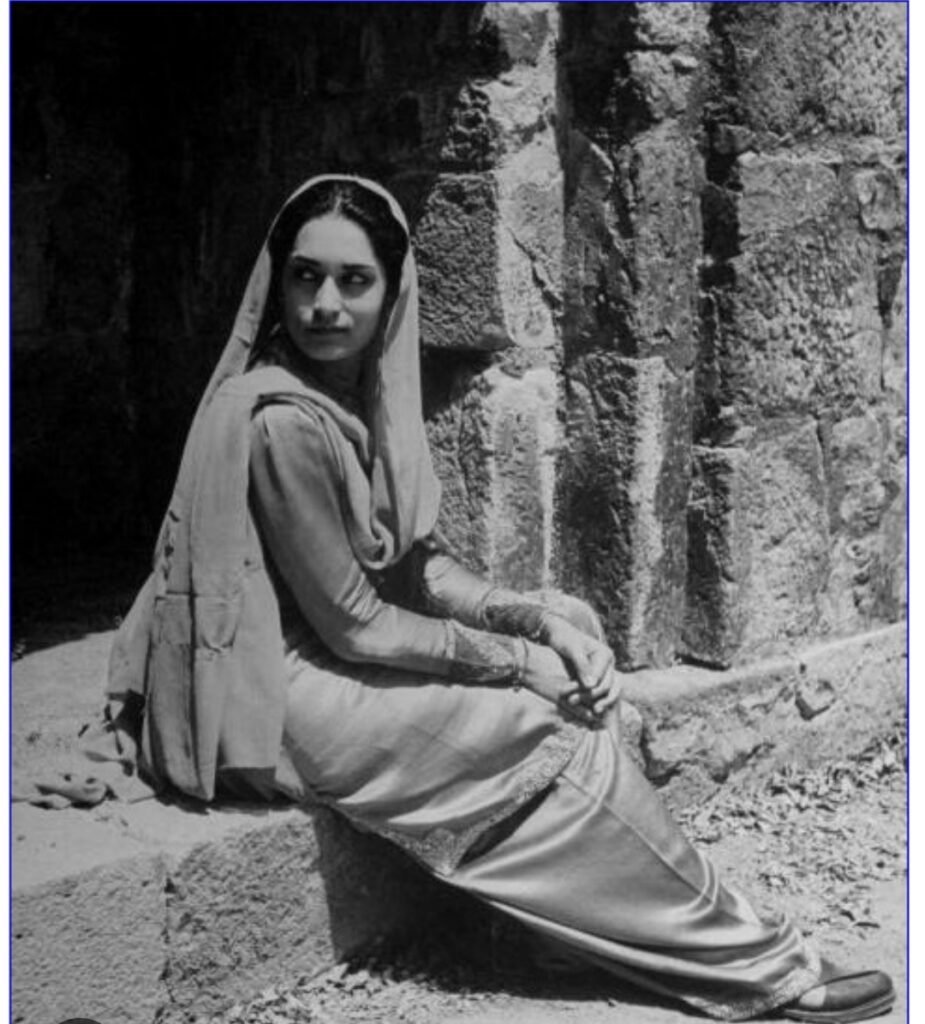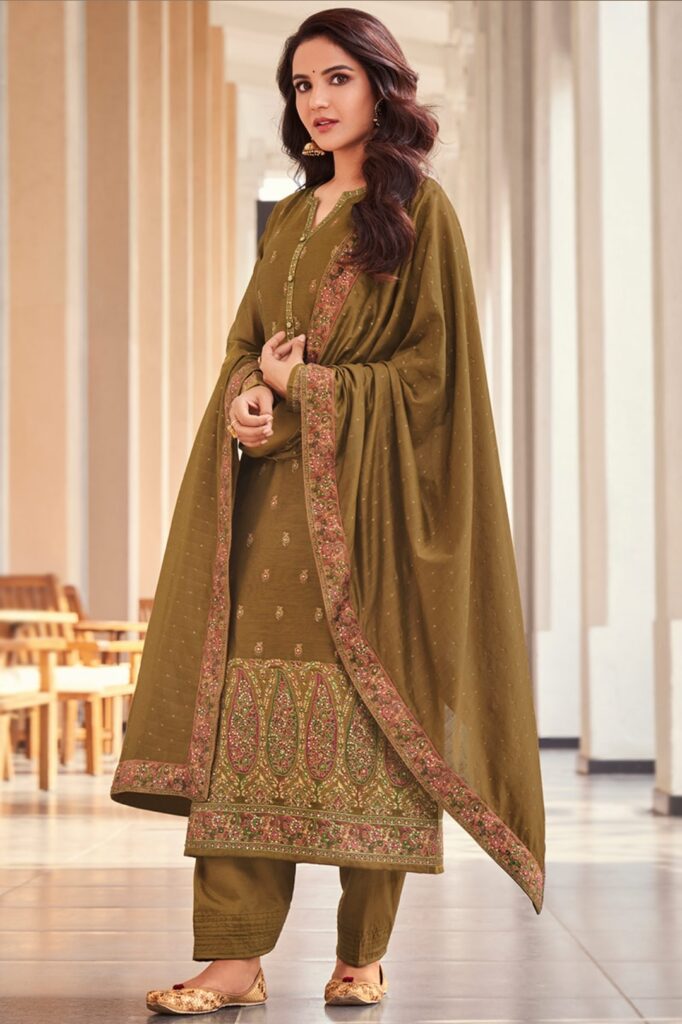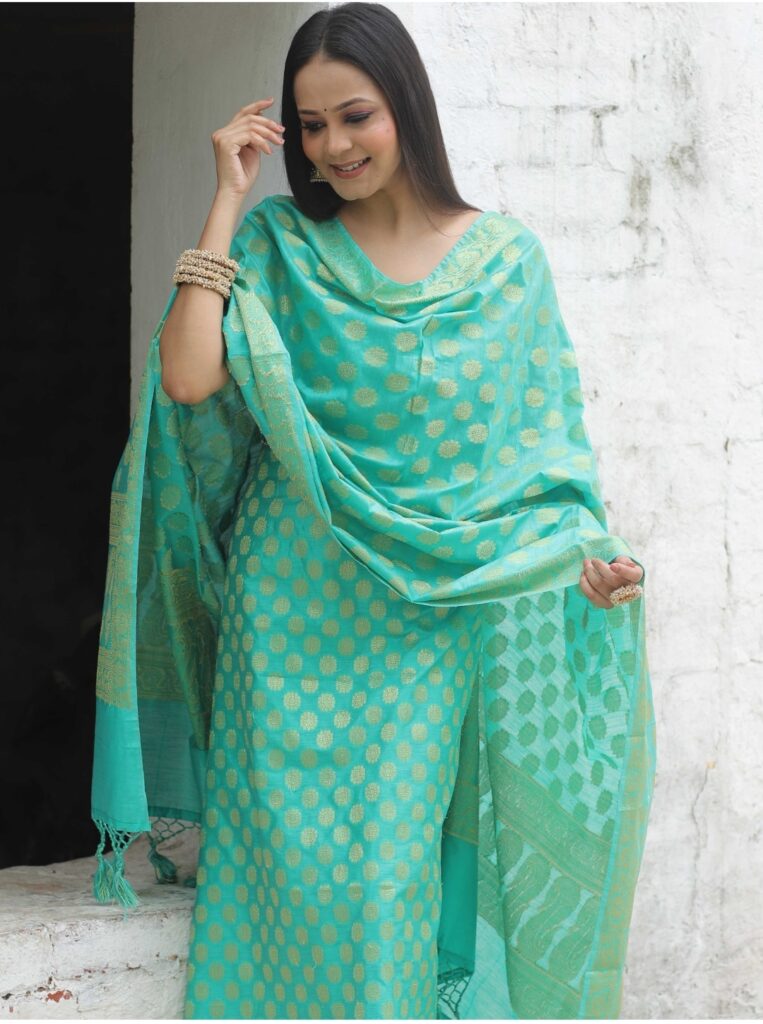Salwar suits, a quintessential part of South Asian fashion, have carved a lasting place in the hearts of women worldwide. Known for their elegance, comfort, and versatility, salwar suits combine traditional aesthetics with contemporary functionality, making them a popular choice for both casual and formal occasions. Whether you’re dressing up for a festival, a wedding, or a simple day at work, the salwar suit is a go-to ensemble that promises style without compromising on comfort.
The Origins of the Salwar Suit

The roots of the salwar suit can be traced back to the Mughal era, when it was introduced as part of the Mughal court’s wardrobe. The combination of a long tunic (the kameez) and loose trousers (the salwar) was a fusion of traditional Central Asian attire and Indian clothing styles. This outfit quickly gained popularity across the Indian subcontinent and evolved into the modern version of the salwar suit that we know today.
Historically, it was designed for comfort and ease of movement, making it the perfect attire for daily wear and work. Over time, the salwar suit underwent various modifications and regional influences, leading to the diverse and vibrant styles we see in modern-day fashion.
Key Elements of a Salwar Suit
A traditional salwar suit consists of three key components: the salwar, the kameez, and the dupatta. Each piece has its unique role, contributing to the overall look and feel of the outfit.

- Salwar (Trousers):
- The salwar is the lower part of the ensemble, a pair of loose, comfortable trousers that are cinched at the waist and ankles. The salwar’s roomy fit allows for easy movement and is perfect for women who are looking for a relaxed, comfortable look. The salwar can come in various styles, from the traditional straight-leg style to the more contemporary churidar (tight at the ankle) or patiala (a voluminous, pleated style).
- Kameez (Tunic):
- The kameez is the upper portion of the salwar suit. It can be long or short, ranging from knee-length to floor-length, and is typically made of soft fabrics like cotton, silk, or chiffon. The kameez is often adorned with beautiful embroidery, prints, or embellishments, depending on the occasion. It can feature a variety of necklines, sleeve lengths, and cuts, allowing for personalization and creativity in styling.
- Dupatta (Scarf):
- The dupatta is the long, flowing scarf or shawl that completes the look. It can be draped over the shoulder or head and is usually made from a complementary fabric or color to match the salwar and kameez. Dupattas often feature intricate embroidery or embellishments and can be used to add a touch of sophistication and elegance to the outfit.
Popular Styles of Salwar Suits
Over the years, salwar suits have evolved into various styles that cater to different tastes and occasions. Each style brings its own charm to the overall outfit.

- Straight Cut Salwar Suit:
- The straight-cut salwar suit features a straight, tailored silhouette. It is elegant and simple, making it perfect for both casual wear and office attire. This style is easy to wear and is ideal for women who prefer a modern and sleek look.
- Anarkali Suit:
- Known for its flowing, bell-shaped design, the Anarkali suit is a timeless classic. It is often worn for weddings and festive occasions, with its long, voluminous skirt and intricate embroidery giving it a regal appeal. The Anarkali suit can be paired with a churidar or a straight-cut salwar, depending on the desired look.
- Patiala Suit:
- The Patiala suit, with its distinct pleated, billowy salwar, is a traditional and stylish choice for women who want comfort and flair. The voluminous salwar creates a dramatic, playful effect, while the kameez is usually fitted and streamlined. This style is often seen in Punjabi culture and is popular for its lively and fun aesthetic.
- Palazzo Suit:
- In recent years, the palazzo suit has gained immense popularity. With its wide-legged trousers and relaxed fit, the palazzo salwar suit offers a contemporary twist on the traditional silhouette. It’s chic, comfortable, and perfect for both formal and semi-formal occasions.
- Churidar Suit:
- The churidar suit features a fitted, pleated salwar that gathers at the ankles. This style is sleek and elongates the legs, making it a flattering choice for many body types. The churidar suit is often paired with long, flowing kameezes or tunics and is a popular choice for festive occasions and celebrations.
Fabrics That Define Salwar Suits
Salwar suits are available in a wide variety of fabrics, each contributing to the overall look and feel of the outfit. From light cottons to luxurious silks, the fabric choice plays a key role in defining the style and occasion for which the salwar suit is meant.

- Cotton: Cotton salwar suits are a staple for everyday wear. They are breathable, soft, and ideal for hot climates. Cotton suits often feature bright colors, playful prints, and minimal embellishments, making them perfect for casual outings and daily use.
- Silk: Silk salwar suits, often adorned with intricate embroidery or embellishments, are popular for weddings and formal events. The rich texture and sheen of silk create a sophisticated and luxurious look, ideal for special occasions.
- Chiffon and Georgette: These lightweight, flowing fabrics are perfect for evening wear. Chiffon and georgette salwar suits have a delicate, ethereal quality and are often adorned with elegant embellishments like sequins, beads, or threadwork.
- Velvet: Velvet salwar suits have gained popularity in the colder months. Their rich texture and deep colors make them perfect for winter weddings, festive occasions, and evening parties.
- Linen and Khadi: For a more traditional, yet modern look, linen and khadi salwar suits are an excellent choice. These fabrics are breathable, comfortable, and perfect for a relaxed, effortless look.
Salwar Suits for Every Occasion
Salwar suits are incredibly versatile and can be dressed up or down depending on the occasion. Whether you’re attending a wedding, going to the office, or simply enjoying a casual day out, there’s a salwar suit to suit your needs.

- For Weddings and Celebrations: Choose rich fabrics like silk, velvet, or brocade. Opt for Anarkali suits, heavily embroidered kameezes, or Patiala suits for a more festive look.
- For Daily Wear: Cotton and linen salwar suits in simple cuts and prints are ideal for everyday wear. Pair them with minimal accessories for a stylish, comfortable look.
- For Office Wear: Straight-cut salwar suits in neutral colors, such as beige, navy, or black, are perfect for a professional setting. You can dress them up with a matching dupatta and sleek accessories.
- For Casual Outings: Go for a palazzo suit or a simple cotton kameez with a light dupatta for a laid-back, trendy look. Add some juttis or flats to complete the outfit.
Why Salwar Suits Are Here to Stay
Salwar suits have stood the test of time, evolving with fashion trends while staying true to their roots. Their comfort, style, and versatility have made them a go-to choice for women of all ages. Whether it’s the intricate detailing of an Anarkali suit or the simplicity of a cotton salwar kameez, this ensemble offers something for everyone.
In a world that is constantly evolving, the salwar suit remains an enduring symbol of grace and elegance. As fashion continues to shift, the salwar suit will undoubtedly remain a timeless and beloved staple in wardrobes across the world. Whether you’re embracing its traditional charm or experimenting with modern twists, the salwar suit is a beautiful celebration of culture, comfort, and style.
Why Salwar Suits Are Comfortable for Indian Women
Salwar suits have become one of the most popular and comfortable traditional outfits for Indian women. Whether worn for everyday activities, at work, or during festive occasions, salwar suits offer a unique blend of comfort, practicality, and style. They have evolved over time to suit modern needs while retaining their cultural significance. In this essay, we explore why salwar suits are considered comfortable by Indian women, focusing on their design, fabric, ease of wear, and cultural context.
1. Loose and Relaxed Fit
One of the primary reasons why salwar suits are favored for their comfort is their loose and relaxed fit. The salwar, which is the bottom half of the suit, is designed to be baggy and free-flowing. It allows for easy movement, making it ideal for women who need to go about their daily tasks, such as working, cooking, or running errands. The salwar is typically designed with a wide, relaxed waistband and leg openings, making it much more comfortable than tight-fitting pants or jeans.
The relaxed fit of the salwar suits is especially appreciated in the hot and humid climates of India. Unlike Western clothing that often adheres tightly to the body, the airiness of salwar suits allows for greater ventilation and airflow, preventing discomfort during long hours of wear. This makes salwar suits particularly ideal during the summer months, providing a cool and breathable alternative to more constricting attire.
2. Soft and Lightweight Fabrics
Salwar suits are generally made from a wide variety of fabrics that prioritize comfort and softness. Cotton, for instance, is one of the most popular choices for everyday wear because it is light, breathable, and gentle on the skin. Other fabrics such as linen, silk, georgette, and chiffon are also used for different occasions. Cotton salwar suits are especially comfortable because they absorb sweat well, which is a major advantage in the warm weather prevalent in many parts of India.
Furthermore, these fabrics are often woven in a way that allows flexibility and stretch, making it easy for women to move around without feeling restricted. The softness and lightness of these fabrics contribute to the overall comfort of salwar suits, ensuring that women feel at ease throughout the day.
3. Ease of Movement
The salwar suit is designed with movement in mind. The wide, flowing salwar gives women the ability to move freely without feeling constricted. This is a huge advantage over more form-fitting attire, such as skirts or trousers, which can be restrictive and uncomfortable. Whether a woman is walking, sitting, or bending, the salwar suit provides the freedom of movement that makes daily activities much easier.
The tunic or kameez, the upper part of the salwar suit, is usually designed to be loose, adding to the overall ease of movement. The long tunic allows women to move their arms freely without worrying about tight sleeves or hems. It’s a design that works for both casual and more formal settings, giving Indian women the flexibility to navigate their daily routines with comfort.
4. Adjustable Fit
Another key aspect of the comfort of salwar suits is their adjustable fit. The salwar, or the bottom portion, typically features a drawstring or elastic waistband, allowing women to adjust it to their preferred fit. This customization ensures that the salwar suit can accommodate different body shapes and sizes, providing a comfortable fit without the need for tailoring or alteration.
The tunic or kameez is similarly adjustable, with various neckline and sleeve options that can be customized to suit the wearer’s preferences. Some salwar suits come with side slits or longer cuts, giving women the option to modify the garment for better comfort. The versatility and adjustability of salwar suits make them an ideal choice for women who seek comfort while maintaining style.
5. Versatility for All Occasions
Salwar suits are extremely versatile, which contributes to their comfort factor. They can be worn for a variety of occasions—from casual outings to formal events—making them a practical option for everyday wear. During the day, women may opt for cotton or linen salwar suits, which are lightweight and easy to wear. In the evening, they can switch to a more elegant fabric like silk or georgette, which offers a more polished look without sacrificing comfort.
For working women, salwar suits are particularly favored as they strike the perfect balance between professionalism and comfort. The loose tunic paired with soft salwars offers a relaxed but polished look, making it suitable for office wear. Whether attending meetings, working from home, or engaging in business trips, the salwar suit provides the right amount of style and ease.
6. Perfect for the Indian Climate
India’s diverse climatic conditions—from hot and humid to cold and dry—make salwar suits an ideal choice of attire. In hot regions, the light and airy fabric of cotton salwar suits allows the body to breathe, preventing overheating. In colder climates, salwar suits can be layered with cardigans, shawls, or jackets without losing their appeal. This adaptability to varying climates is one reason why salwar suits remain popular across the country.
The loose fit of the salwar also helps in regulating body temperature by ensuring there is adequate airflow around the body. This is particularly important for women who live in areas with extreme heat, where wearing tight clothing can cause discomfort. Salwar suits, therefore, offer both practical benefits and comfort in various weather conditions.
7. Practical for All Body Types
Salwar suits are designed to suit a wide range of body types. The loose tunic can be adjusted to fit different body shapes comfortably, allowing women of all sizes to wear them without feeling restricted. The salwar, being wide and flowing, is forgiving and accommodates a variety of body shapes without making women feel self-conscious about their appearance.
Additionally, the salwar suit can be easily styled in many different ways to suit personal preferences. It can be paired with a scarf, shawl, or dupatta for added elegance, or worn simply with a simple, minimalistic style for a more relaxed look. The ability to modify the outfit makes it an attractive and comfortable choice for women of all ages and body types.
8. Convenience of Wearing and Taking Off
Unlike sarees, which require intricate draping techniques, salwar suits are easy to wear and take off. The tunic or kameez simply slips over the head, and the salwar can be adjusted with a drawstring or elastic waistband. This ease of wear is particularly important for women with busy lifestyles who need to get ready quickly without worrying about complicated dressing techniques.
Moreover, salwar suits require less maintenance than sarees or other traditional outfits. They are easy to wash, do not need to be starched or ironed excessively, and can be worn multiple times without losing their appeal.
Conclusion
Salwar suits have earned their place as one of the most comfortable and practical traditional garments for Indian women. Their loose fit, soft fabrics, ease of movement, and versatility make them ideal for a range of occasions, from casual outings to formal events. In addition to their comfort, salwar suits also provide women with the freedom to express their individuality while adhering to cultural traditions. With their adaptability to India’s diverse climate, body types, and lifestyles, salwar suits continue to be a beloved choice for women across the country, offering a perfect combination of comfort and style.